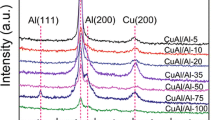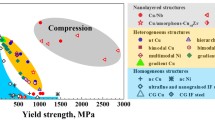Abstract
This paper presents the first effort to investigate the effects of uniform and nonuniform prestraining on the mechanical properties of nanostructured multilayers. Thin muscovite sheets were first subjected to a loading–unloading cycle under unidirectional compression and cantilever bending modes that induce uniform and nonuniform prestraining, respectively, and then probed by nanoindentation to characterize their Young’s modulus and hardness. Optical and electron microscopy and X-ray diffraction were also used to uncover prestraining-induced microstructure alterations. Precompression in the c* direction to a stress of 45 MPa induces elastic uniform straining and causes negligible alteration to the microstructure. Such a prestrained specimen possesses unaltered Young’s modulus and hardness. However, the nonuniformly prestrained specimens that were subjected to cantilever bending, even though bending is macroscopically purely elastic, exhibit decreased Young’s modulus and hardness, and such reduction depends on the magnitude of bending strains. The Young’s modulus decreases by up to 41.0%, from 69.5 to 41.0 GPa at 0 to ~ 6% bending strains, respectively, while the maximum hardness reduction is 40.4%. Such distinction induced by different prestraining modes stems from the bending-induced nonuniform straining as well as the muscovite’s unique nanoscale layered structure. Owing to the relatively weaker and reversible electrostatic interlayer bonding, bending-induced strain gradient along the c* direction causes relative interlayer slip and hence bonding switch and, upon unloading, leads to the formation of basal plane corrugation and subsurface blisters. Such structural incoherence and imperfections induced by even elastic bending reduce the Young’s modulus and hardness. These findings shed light on the processing–structure–property relationships for other nanostructured multilayers as well as the origin of variability of elastic modulus of muscovites reported in the literature.












Similar content being viewed by others
References
Guggenheim S, Vhang YH, Van Groos Koster AF (1987) Muscovite dehydroxylation: high temperature studies. Am Miner 72:537–550
Scott AD, Smith SJ (1967) Visible changes in macro mica particles that occur with potassium depletion. Clays Clay Miner 15:357–373. https://doi.org/10.1346/CCMN.1967.0150138
Helgeson HC, Delany JM, Nesbitt HW, Bird DK (1978) Summary and critique of the thermodynamic properties of rock-forming minerals. Am J Sci 278:1–229
Routson RC, Kittrick JA (1971) Illite solubility. Soil Sci Soc Am Proc 35:714–718
Sone H, Zoback MD (2013) Mechanical properties of shale-gas reservoir rocks, part 1: static and dynamic elastic properties and anisotropy. Geophysics 78:D381–D392. https://doi.org/10.1190/geo2013-0050.1
Sone H, Zoback MD (2013) Mechanical properties of shale-gas reservoir rocks, part 2: ductile creep, brittle strength, and their relation to the elastic modulus. Geophysics 78:D393–D402. https://doi.org/10.1190/geo2013-0051.1
Bayuk IO, Ammerman M, Chesnokov EM (2007) Elastic moduli of anisotropic clay. Geophysics 72:D107. https://doi.org/10.1190/1.2757624
Sayers CM, Den Boer LD (2016) The elastic anisotropy of clay minerals. Geophysics 81:C193–C203. https://doi.org/10.1190/geo2016-0005.1
Mondol NH, Jahren J, Bjørlykke K, Brevik I (2008) Elastic properties of clay minerals. Lead Edge 27:758. https://doi.org/10.1190/1.2944163
Teich-McGoldrick SL, Greathouse JA, Cygan RT (2012) Molecular dynamics simulations of structural and mechanical properties of muscovite: pressure and temperature effects. J Phys Chem C 116:15099–15107. https://doi.org/10.1021/jp303143s
Vaughan M, Guggenheim S (1986) Elasticity of muscovite and its relationship to crystal structure. J Geophys Res 91:4657. https://doi.org/10.1029/JB091iB05p04657
Terzaghi K (1931) The influence of elasticity and permeability on the swelling of two-phase systems. In: Alexander J (ed) Colloid chemistry. Chemical Catalog Co., New York, pp 65–88
Mitchell JK, Moore CA (1974) Electromagnetic forces and soil strength. Géotechnique 24:627–640. https://doi.org/10.1680/geot.1974.24.4.627
Denison IA, Fry WH, Gile PL (1929) Alteration of muscovite and biotite in the soil. Technical Bulletin 128
Wu PC, Chen PF, Do TH et al (2016) Heteroepitaxy of Fe3O4/muscovite: a new perspective for flexible spintronics. ACS Appl Mater Interfaces 8:33794–33801. https://doi.org/10.1021/acsami.6b11610
Ke S, Chen C, Fu N et al (2016) Transparent indium tin oxide electrodes on muscovite mica for high-temperature-processed flexible optoelectronic devices. ACS Appl Mater Interfaces 8:28406–28411. https://doi.org/10.1021/acsami.6b09166
Low CG, Zhang Q (2012) Ultra-thin and flat mica as gate dielectric layers. Small 8:2178–2183. https://doi.org/10.1002/smll.201200300
Imazono T, Hirono T, Kimura H et al (2005) Polarizance of a synthetic mica crystal polarizer and the degree of linear polarization of an undulator beamline at 880 eV evaluated by the rotating-analyzer method. Rev Sci Instrum 76:126106. https://doi.org/10.1063/1.2140492
Taruta S, Obara R, Takusagawa N, Kitajima K (2005) Effect of layer charge on chemical and physical properties of synthetic K-fluorine micas. J Mater Sci 40:5597–5602. https://doi.org/10.1007/s10853-005-1428-7
Gebhardt A, Höche T, Carl G, Khodos II (1999) TEM study on the origin of cabbage-shaped mica crystal aggregates in machinable glass-ceramics. Acta Mater 47:4427–4434. https://doi.org/10.1016/S1359-6454(99)00317-1
Höche T, Habelitz S, Avramov I (1999) Crystal morphology engineering in SiO2–Al2O3–MgO–K2O–Na2O–F-mica glass-ceramics. Acta Mater 47:735–744. https://doi.org/10.1016/S1359-6454(98)00424-8
Habelitz S, Höche T, Hergt R et al (1999) Microstructural design through epitaxial growth in extruded mica glass-ceramics. Acta Mater 47:2831–2840. https://doi.org/10.1016/S1359-6454(99)00135-4
Riedrich-Möller J, Arend C, Pauly C et al (2014) Deterministic coupling of a single silicon-vacancy color center to a photonic crystal cavity in diamond. Nano Lett 14:5281–5287. https://doi.org/10.1021/nl502327b
Hölzer G, Wehrhan O, Heinisch J et al (1998) Flat and spherically bent muscovite (mica) crystals for X-ray spectroscopy. Phys Scr 57:301–309. https://doi.org/10.1088/0031-8949/57/2/029
Fu YT, Zartman GD, Yoonessi M et al (2011) Bending of layered silicates on the nanometer scale: mechanism, stored energy, and curvature limits. J Phys Chem C 115:22292–22300. https://doi.org/10.1021/jp208383f
Barsoum MW, Murugaiah A, Kalidindi SR, Zhen T (2004) Kinking nonlinear elastic solids, nanoindentations, and geology. Phys Rev Lett 92:255508. https://doi.org/10.1103/PhysRevLett.92.255508
Mariani E, Brodie KH, Rutter EH (2006) Experimental deformation of muscovite shear zones at high temperatures under hydrothermal conditions and the strength of phyllosilicate-bearing faults in nature. J Struct Geol 28:1569–1587. https://doi.org/10.1016/j.jsg.2006.06.009
Van Diggelen E, De Bresser J, Peach CJ, Spiers CJ (2010) High shear strain behaviour of synthetic muscovite fault gouges under hydrothermal conditions. J Struct Geol 32:1685–1700. https://doi.org/10.1016/j.jsg.2009.08.020
Smyth JR, Jacobsen SD, Swope RJ et al (2000) Crystal structures and compressibilities of synthetic 2M1 and 3T phengite micas. Eur J Miner 12:955–963. https://doi.org/10.1127/0935-1221/2000/0012-0955
Comodi P, Zanazzi FP (1995) High-pressure structural study of muscovite. Phys Chem Miner 22:170–177. https://doi.org/10.1007/BF00202297
Knyazev SA, Korsukov VE (2004) Transformation of the surface structure of bending-strained muscovite crystals. Tech Phys Lett 30:463–465. https://doi.org/10.1134/1.1773336
Faust J, Knittle E (1994) Static compression of chondrodite: implications for water in the upper mantle. Geophys Res Lett 21:1935–1938. https://doi.org/10.1029/94GL01592
Griggs J, Lang AC, Gruber J et al (2017) Spherical nanoindentation, modeling and transmission electron microscopy evidence for ripplocations in Ti3SiC2. Acta Mater 131:141–155. https://doi.org/10.1016/j.actamat.2017.03.055
Gruber J, Lang AC, Griggs J et al (2016) Evidence for bulk ripplocations in layered Solids. Sci Rep 6:1–8. https://doi.org/10.1038/srep33451
Yoder HS, Eugster HP (1955) Synthetic and natural muscovites. Geochim Cosmochim Acta 8:225–280. https://doi.org/10.1016/0016-7037(55)90001-6
McNeil LE, Grimsditch M (1993) Elastic moduli of muscovite mica. J Phys Condens Matter 5:1681–1690. https://doi.org/10.1088/0953-8984/5/11/008
Sekine T, Rubin AM, Ahrens TJ (1991) Shock wave equation of state of muscovite. J Geophys Res Solid Earth 96:19675–19680. https://doi.org/10.1029/91JB02253
Alexandrov KS, Ryzhova TV (1961) Elastic properties of rock-forming minerals. II Layered silicates. Bulletin of the Academy of Sciences of the USSR Geophysics Series. Pergamon Press, New York, pp 1165–1168
Zhang G, Wei Z, Ferrell RE et al (2010) Evaluation of the elasticity normal to the basal plane of non-expandable 2:1 phyllosilicate minerals by nanoindentation. Am Miner 95:863–869. https://doi.org/10.2138/am.2010.3398
Zhang J, Hu L, Pant R et al (2013) Effects of interlayer interactions on the nanoindentation behavior and hardness of 2:1 phyllosilicates. Appl Clay Sci 80–81:267–280. https://doi.org/10.1016/j.clay.2013.04.013
Menčík J, Munz D, Quandt E et al (1997) Determination of elastic modulus of thin layers using nanoindentation. J Mater Res 12:2475–2484. https://doi.org/10.1557/JMR.1997.0327
Mavko G, Mukerji T, Dvokin J (1998) The rock physics handbook. Cambridge University Press, New York
Faust J, Knittle E (1994) The equation of state, amorphization, and high-pressure phase diagram of muscovite. J Geophys Res Solid Earth 99:19785–19792. https://doi.org/10.1029/94JB01185
Zartman GD, Liu H, Akdim B et al (2010) Nanoscale tensile, shear, and failure properties of layered silicates as a function of cation density and stress. J Phys Chem C 114:1763–1772. https://doi.org/10.1021/jp907012w
Caslavsky JL, Vedam K (1970) Muscovites with isotropic and anisotropic elasticity in the basal plane. Am Miner 55:1633–1638
Hull D (1997) The geometry of cracks and blisters in mica. Acta Mater 45:233–244. https://doi.org/10.1016/S1359-6454(96)00162-0
Amelinckx S (1952) La Croissance Helicoidale de Cristaux du Biotite. C. R. Acad. Sci, Paris
Amelinckx S, Delavignette P (1960) Observation of dislocations in non-metallic layer structures. Nature 185:603–604. https://doi.org/10.1038/185603a0
Zhang G, Wei Z, Ferrell RE (2009) Reply to the Comment on “Elastic modulus and hardness of muscovite and rectorite determined by nanoindentation” by G. Zhang, Z. Wei and R. E. Ferrell [Applied Clay Science 43 (2009) 271–281]. Appl Clay Sci 46:429–432. https://doi.org/10.1016/j.clay.2009.08.009
Zhang G, Wei Z, Ferrell RE (2009) Elastic modulus and hardness of muscovite and rectorite determined by nanoindentation. Appl Clay Sci 43:271–281. https://doi.org/10.1016/j.clay.2008.08.010
Nix WD, Gao HJ (1998) Indentation size effects in crystalline materials: a law for strain gradient plasticity. J Mech Phys Solids 46:411–425. https://doi.org/10.1016/s0022-5096(97)00086-0
Castellanos-Gomez A, Poot M, Amor-Amorós A et al (2012) Mechanical properties of freely suspended atomically thin dielectric layers of mica. Nano Res 5:550–557. https://doi.org/10.1007/s12274-012-0240-3
Acknowledgements
This first author, Fuli Ma, was supported by a visiting student scholarship from the China Scholarship Council (No. 201406930009), Postgraduate Innovation Foundation of Shanxi Province (No. 20133034) and National Natural Science Foundation of China (Nos. 51178287, 51578359). Shengmin Luo received partial support from the Student Research Grant of the US Clay Minerals Society as well as partial support from Hess Corporation under the supervision of Dr. Keith Katahara.
Author information
Authors and Affiliations
Corresponding author
Rights and permissions
About this article
Cite this article
Ma, F., Song, J., Luo, S. et al. Distinct responses of nanostructured layered muscovite to uniform and nonuniform straining. J Mater Sci 54, 1077–1098 (2019). https://doi.org/10.1007/s10853-018-2887-y
Received:
Accepted:
Published:
Issue Date:
DOI: https://doi.org/10.1007/s10853-018-2887-y




